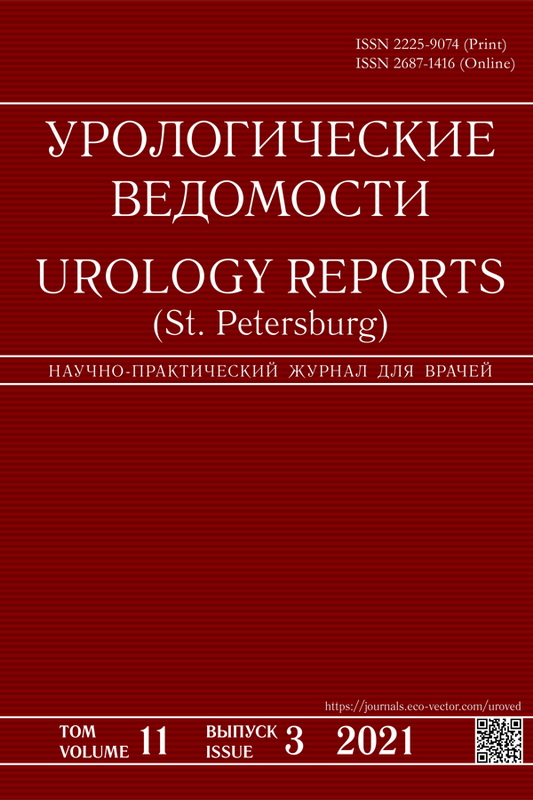作为局限性前列腺癌患者预后标志物的前列腺特异性抗原密度
- 作者: Kneev A.Y.1, Shkolnik M.I.1, Bogomolov O.A.1, Vershinskaya J.G.1, Zharinov G.M.1
-
隶属关系:
- Russian Scientific Center of Radiology and Surgical Technologies named after A.M. Granov
- 期: 卷 11, 编号 3 (2021)
- 页面: 205-212
- 栏目: Original articles
- URL: https://ogarev-online.ru/uroved/article/view/71614
- DOI: https://doi.org/10.17816/uroved71614
- ID: 71614
如何引用文章
详细
绪论。在改善前列腺癌患者治疗结果的领域中,最重要的任务是按风险组正确分层。现代分层系统不能为所有前列腺癌患者提供充分的风险评估。用于预测特定患者前列腺癌临床病程的算法的进一步开发可以积极影响疾病的病程和结果。
目的:前列腺特异性抗原(pPSA)密度在接受激素联合放射治疗的局限性前列腺癌患者中的临床和预后价值测定。
材料与方法。在1996年1月至2007年7月期间接受联合激素放射治疗的272例局限性前列腺癌患者中,评估了pPSA参数对肿瘤特异性生存率以及肿瘤过程的临床和形态学参数的影响。
结果。pPSA指标的高度临床意义已得到证实。PPSA的增加与血清PSA浓度的增加、PSA倍增时间的减少以及肿瘤分化的减少相关。pPSA的预后价值在接受联合激素放射治疗的局限性前列腺癌患者中得到证实。使用ROC分析,确定pPSA指数的阈值为—0.36 ng/(ml/cm3),超过该阈值与肿瘤特异性生存水平的统计学显著降低相关。曲线下面积为0.703(95% CI 0.236–0.434;p<0.001)。随着pPSA值的增加,肿瘤特异性死亡和复发的风险也会增加。
结论。pPSA参数是一种可靠的前列腺癌生物标志物,具有很高的临床和预后意义,其使用与引入昂贵且繁琐的实验室和仪器诊断方法无关。
作者简介
Alexey Kneev
Russian Scientific Center of Radiology and Surgical Technologies named after A.M. Granov
编辑信件的主要联系方式.
Email: alexmedspb@gmail.com
ORCID iD: 0000-0002-5899-8905
SPIN 代码: 8015-1529
Postgraduate Student
俄罗斯联邦, 70, Leningradskaya str., Pesochnyi vil., 197758, Saint PetersburgMichail Shkolnik
Russian Scientific Center of Radiology and Surgical Technologies named after A.M. Granov
Email: shkolnik_phd@mail.ru
ORCID iD: 0000-0003-0589-7999
SPIN 代码: 4743-9236
Dr. Sci. (Med.), Chief Researcher
俄罗斯联邦, 70, Leningradskaya str., Pesochnyi vil., 197758, Saint PetersburgOleg Bogomolov
Russian Scientific Center of Radiology and Surgical Technologies named after A.M. Granov
Email: urologbogomolov@gmail.com
ORCID iD: 0000-0002-5860-9076
SPIN 代码: 6554-4775
Cand. Sci. (Med.), Research Fellow, Urologist
俄罗斯联邦, 70, Leningradskaya str., Pesochnyi vil., 197758, Saint PetersburgJulia Vershinskaya
Russian Scientific Center of Radiology and Surgical Technologies named after A.M. Granov
Email: yuliya_yakovleva95@mail.ru
ORCID iD: 0000-0003-2141-2576
Postgraduate Student
俄罗斯联邦, 70, Leningradskaya str., Pesochnyi vil., 197758, Saint PetersburgGennady Zharinov
Russian Scientific Center of Radiology and Surgical Technologies named after A.M. Granov
Email: asatur15@mail.ru
ORCID iD: 0000-0002-6034-2040
SPIN 代码: 6010-9551
Dr. Sci. (Med.), Chief Researcher
俄罗斯联邦, 70, Leningradskaya str., Pesochnyi vil., 197758, Saint Petersburg参考
- Zlokachestvennye novoobrazovanija v Rossii v 2018 godu (zabolevaemost’ i smertnost’). Kaprina AD. Starinskogo VV, Petrovoj GV., editors. Moscow: MNIOI. PA. Gercena filial FGBU “NMIC radiologii” Minzdrava Rossii. 2019. 250 p.
- Partin AW, Kattan MW, Subong EN, et al. Combination of prostate-specific antigen, clinical stage, and Gleason score to predict pathological stage of localized prostate cancer. A multi-institutional update. JAMA. 1997;277(18):1445–1451.
- D’Amico AV, Whittington R, Malkowicz SB, et al. Combined modality staging of prostate carcinoma and its uti¬lity in predicting pathologic stage and postoperative prostate specific antigen failure. Urology. 1997;49(3A Suppl):23–30. doi: 10.1016/S0090-4295(97)00165-9
- Ramos N, Macedo A, Rosa J, Carvalho M. Perineural invasion in prostate needle biopsy: Prognostic value on radical prostatectomy and active surveillance. Arch Ital Urol Androl. 2020;92(4). doi: 10.4081/aiua.2020.4.330
- Brimo F, Montironi R, Egevad L, et al. Contemporary gra¬ding for prostate cancer: implications for patient care. Eur Urol. 2013;63(5):892–901. doi: 10.1016/j.eururo.2012.10.015
- Wilkinson BA, Hamdy FC. State-of-the-art staging in prostate cancer. BJU Int. 2001;87(5):423–430. doi: 10.1046/j.1464-410x.2001.02146.x
- Sved PD, Gomez P, Manoharan M, et al. Limitations of biopsy Gleason grade: implications for counseling patients with biopsy Gleason score 6 prostate cancer. J Urol. 2004;172(1):98–102. doi: 10.1097/01.ju.0000132135.18093.d6
- Saad F, Latour M, Lattouf JB, et al. Biopsy Based Proteomic Assay Predicts Risk of Biochemical Recurrence after Radical Prostatectomy. J Urol. 2017;197(4):1034–1040. doi: 10.1016/j.juro.2016.09.116
- Zhang Y, Zhang P, Wan X, et al. Downregulation of long non-coding RNA HCG11 predicts a poor prognosis in prostate cancer. Biomed Pharmacother. 2016;83:936–941. doi: 10.1016/j.biopha.2016.08.013
- Benson MC, Whang IS, Pantuck A, et al. Prostate specific antigen density: a means of distinguishing benign prostatic hypertrophy and prostate cancer. J Urol. 1992;147(3 Pt 2):815–816. doi: 10.1016/s0022-5347(17)37393-7
- Kanehara H, Ueda H, Katsuoka Y. [The efficacy of PSA density for the early detection of prostate cancer]. Nihon Rinsho. 1998;56(8):2012–2015. (In Japan.)
- Tarone RE, Chu KC, Brawley OW. Implications of stage-specific survival rates in assessing recent declines in prostate cancer mortality rates. Epidemiology. 2000;11(2):167–170. doi: 10.1097/00001648-200003000-00014
- Benson MC, Whang IS, Olsson CA, et al. The use of prostate specific antigen density to enhance the predictive value of intermediate levels of serum prostate specific antigen. J Urol. 1992;147(3 Pt 2): 817–821. doi: 10.1016/s0022-5347(17)37394-9
- Presti JC Jr, Hovey R, Carroll PR, Shinohara K. Prospective evaluation of prostate specific antigen and prostate specific antigen density in the detection of nonpalpable and stage T1C carcinoma of the prostate. J Urol. 1996;156(5):1685–1690.
- Ohori M, Wheeler TM, Dunn JK, et al. The pathological features and prognosis of prostate cancer detectable with current diagnostic tests. J Urol. 1994;152(5 Pt 2):1714–1720. doi: 10.1016/s0022-5347(17)32369-8
- Epstein JI, Sanderson H, Carter HB, Scharfstein DO. Utility of saturation biopsy to predict insignificant cancer at radical prostatectomy. Urology. 2005;66(2):356–360. doi: 10.1016/j.urology.2005.03.002
- Zentner PG, Pao LK, Benson MC, et al. Prostate-specific antigen density: a new prognostic indicator for prostate cancer. Int J Radiat Oncol Biol Phys. 1993;27(1):47–58. doi: 10.1016/0360-3016(93)90420-z
- Corn BW, Hanks GE, Lee WR, et al. Prostate specific antigen density is not an independent predictor of response for prostate cancer treated by conformal radiotherapy. J Urol. 1995;153(6):1855–1859
- Pollack A, Lankford S, Zagars GK, Babaian RJ. Prostate specific antigen density as a prognostic factor for patients with prostate carcinoma treated with radiotherapy. Cancer. 1996;77(8):1515–1523. doi: 10.1002/(SICI)1097-0142(19960415)77:8<1515
补充文件








